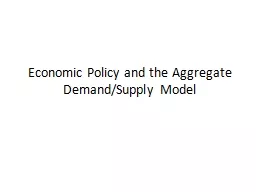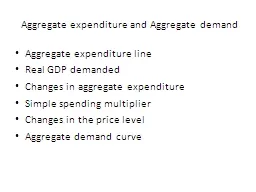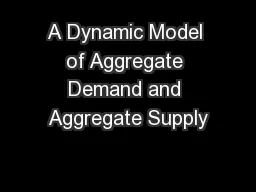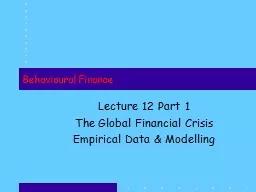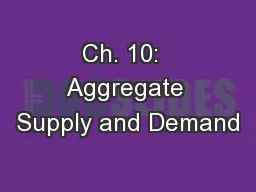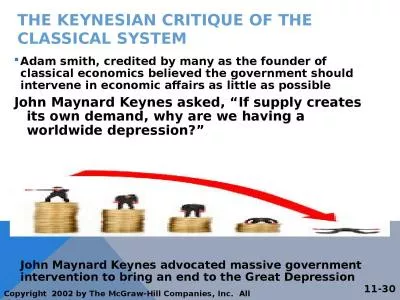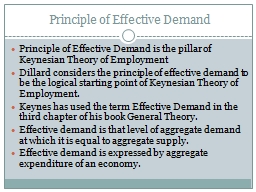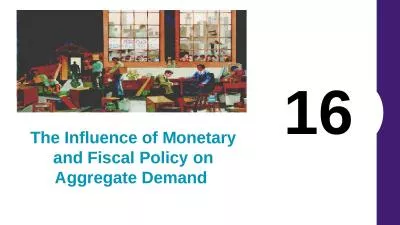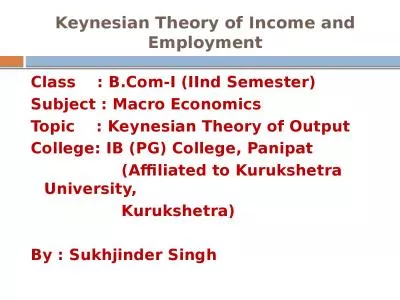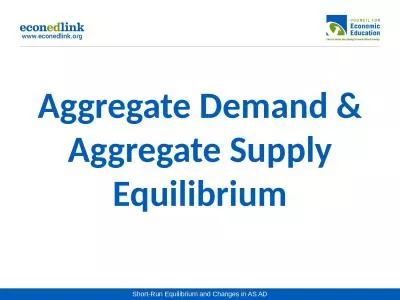PPT-Economic Policy and the Aggregate Demand/Supply Model
Author : giovanna-bartolotta | Published Date : 2016-06-29
Macroeconomic Policy A Policy in the Face of Demand Shocks B Responding to Supply Shocks Fiscal Policy The Basics A Taxes Purchases of Goods and Services Government
Presentation Embed Code
Download Presentation
Download Presentation The PPT/PDF document "Economic Policy and the Aggregate Demand..." is the property of its rightful owner. Permission is granted to download and print the materials on this website for personal, non-commercial use only, and to display it on your personal computer provided you do not modify the materials and that you retain all copyright notices contained in the materials. By downloading content from our website, you accept the terms of this agreement.
Economic Policy and the Aggregate Demand/Supply Model: Transcript
Macroeconomic Policy A Policy in the Face of Demand Shocks B Responding to Supply Shocks Fiscal Policy The Basics A Taxes Purchases of Goods and Services Government Transfers and Borrowing. 29. McGraw-Hill/Irwin. Copyright © 2012 by The McGraw-Hill Companies, Inc. All rights reserved.. Aggregate Demand. Real GDP desired at each price level. Inverse relationship. Real balances effect. Aggregate expenditure line. Real GDP demanded. Changes in aggregate expenditure. Simple spending multiplier. Changes in the price level. Aggregate demand curve. Components of aggregate expenditure (AE). Chapter . 15 . of . Macroeconomics. , . 8. th. . edition, by N. Gregory . Mankiw. ECO62. . Udayan. . Roy. PART V Topics in Macroeconomic Theory. Inflation and dynamics in the short run. So far, to analyze the short run we have used. Chapter 11. Copyright © 2015 McGraw-Hill Education. All rights reserved. No reproduction or distribution without the prior written consent of McGraw-Hill Education.. Chapter 11: Learning Objectives. Stabilization Policies and Their Effects. E. 2. Expansionary Fiscal Policy: Addressing Recessionary Gaps. Suppose a . negative demand shock . has caused a recession. . AD. 2. AD. 1. Aggregate . Price Level. Lecture 12 Part 1. The Global Financial Crisis. Empirical Data & . Modelling. Biggest crisis since the Great Depression... For . almost. every country. Australia (you’re standing in it) the exception. Derive AS/AD model . Understand cause & consequences of change in AS/AD. Short run vs Long run. Effects on economic growth, prices, unemployment.. Different schools of thought in macroeconomics. Macroeconomic Long Run and Short Run. Day 1. Q1: During the Great Depression we saw a rise in unemployment and deflation. In the recession of 1979-1982 a rise in unemployment but inflation. Why?. Q2: What is stagflation?. Aggregate Supply and Aggregate Demand. . Adam . smith, credited by many as the founder of classical economics believed the government should intervene in economic affairs as little as possible. John Maynard Keynes asked, “If supply creates its own demand, why are we having a worldwide depression?”. Principle of Effective Demand is the pillar of Keynesian Theory of Employment. Dillard considers the principle of effective demand to be the logical starting point of Keynesian Theory of Employment.. The Influence of Monetary and Fiscal Policy on Aggregate Demand. Monetary policy refers to the control of a country’s quantity of money by its central bank. We saw the . long-run effects. of monetary policy in Chapter 12 (Money Growth and Inflation). Principles of Macro Economics 1. ECONA 201. Introduction to Macroeconomics. Macroeconomics. deals with the economy as a whole; it examines the behavior of economic aggregates such as aggregate income, consumption, investment, and the overall level of prices.. Class : B.Com-I (IInd Semester). Subject : Macro Economics. Topic : Keynesian Theory of Output. College: IB (PG) College, Panipat. (Affiliated to Kurukshetra University, . . AD - The Model. PL. RGDP. AD. PL = Price Level. ALL prices in the economy. Real Gross Domestic Product = Dollar value of ALL domestically produced final goods and services adjusted for inflation. AD = Aggregate demand. The total amount of goods and services people will purchase at ALL price levels. Has the same components as GDP..
Download Rules Of Document
"Economic Policy and the Aggregate Demand/Supply Model"The content belongs to its owner. You may download and print it for personal use, without modification, and keep all copyright notices. By downloading, you agree to these terms.
Related Documents

